#long-tailed sylph
Explore tagged Tumblr posts
Text

birdies (again!)
#these two were rejects from the first batch because the designs were too busy#I still like them though :)#just two scene kids hanging out#my little pony#mlp#pigeon#long-tailed sylph
154 notes
·
View notes
Text

Long-tailed sylph (Aglaiocercus kingii)
Photo by Fernando Burgalin Sequeria
#Aglaiocercus kingii#Aglaiocercus#long-tailed sylph#sylph#hummingbird#lesbiini#lesbiinae#south american birds#birds#blue#green#blue birds#green birds#tropical birds#nature#animals#wildlife#blue and green
2K notes
·
View notes
Text

50 notes
·
View notes
Text

🌿 𝓛𝓸𝓷𝓰 𝓽𝓪𝓲𝓵𝓮𝓭 𝓼𝔂𝓵𝓹𝓱𝓼 🌿
29 notes
·
View notes
Text
Battle Royale
Family Reunion (C-4)
Some families are more popular than others, you know? It's a miracle there wasn't a submission for ever single corvid that's ever existed. Instead, we have these guys.

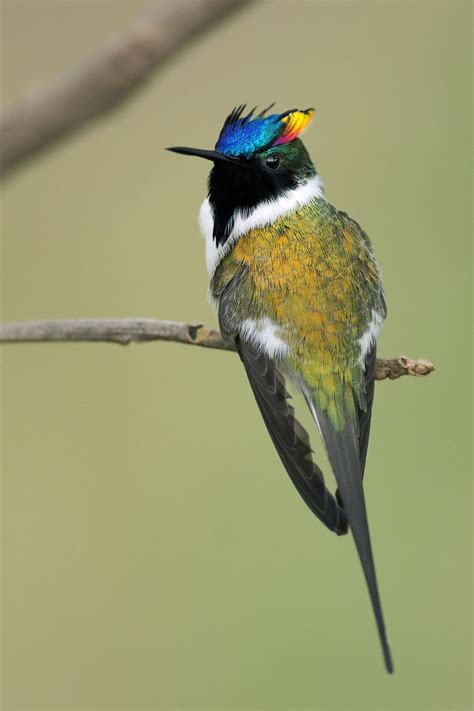
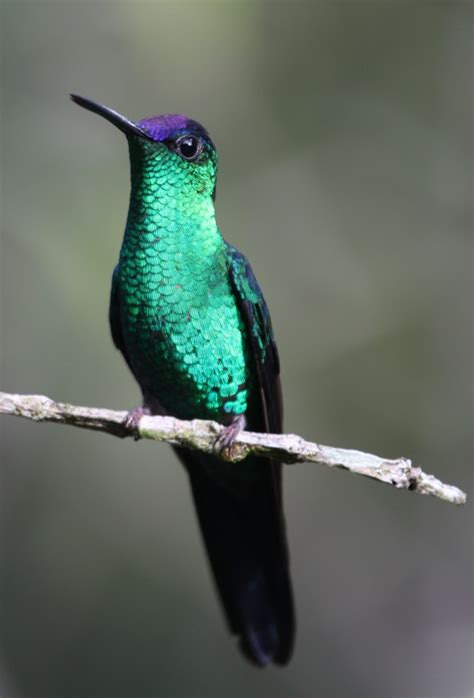

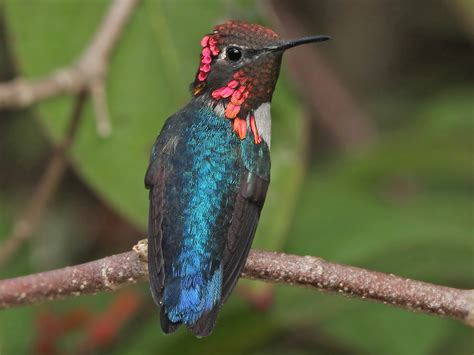
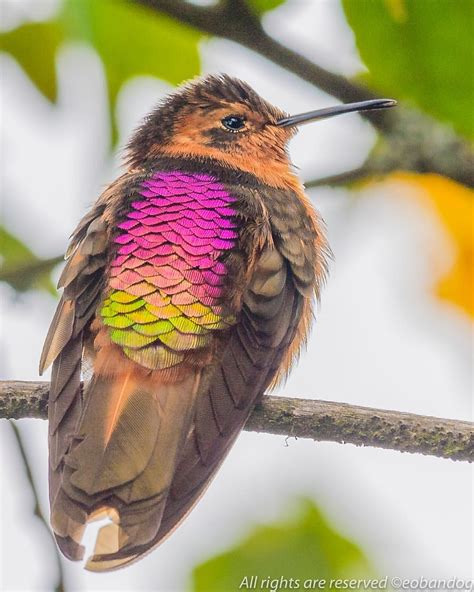

#Hipster Bird Battle Royale#BR-C#wine throated hummingbird#horned sungem#violet capped woodnymph#long tailed sylph#red tailed comet#bee hummingbird#shining sunbeam#trochilidae
30 notes
·
View notes
Video
The Pink Cafe by Naser Mojtahed Via Flickr: Long-Tailed Sylph hummingbird Captured in Ecuador
4 notes
·
View notes
Text
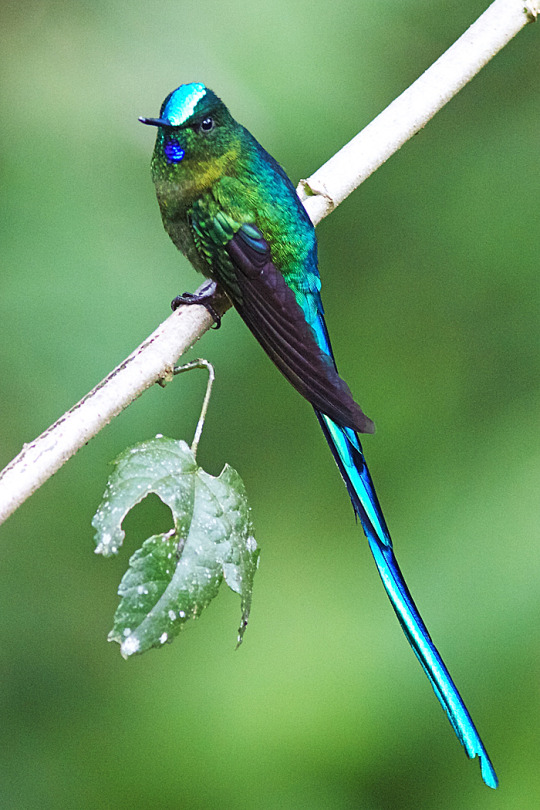
Long-tailed Sylph (Aglaiocercus kingii mocoa), family Trochilidae, order Apodiformes, Ecuador
photograph by Joseph C Boone
#hummingbird#sylph#aglaiocercus#trochilidae#apodiformes#bird#ornithology#animals#nature#south america
344 notes
·
View notes
Text

Inktober 2024 - Day 30 ✨
Long-tailed Sylph (Aglaiocercus kingii)
#art#artists on tumblr#my art#artwork#sketch#sketchbook#traditional art#traditional illustration#traditional drawing#traditional sketch#inktober#watercolourpainting#watercolour sketch#watercolour illustration#watercolour art#watercolor#birbs of tumblr#birb art#cute birbs#birblr#birds of tumblr#bird art#bird drawing#bird#birds
96 notes
·
View notes
Text
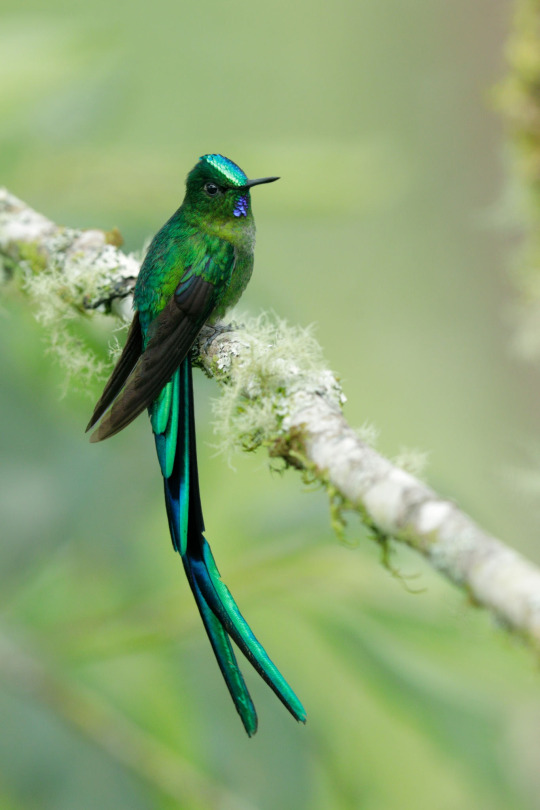
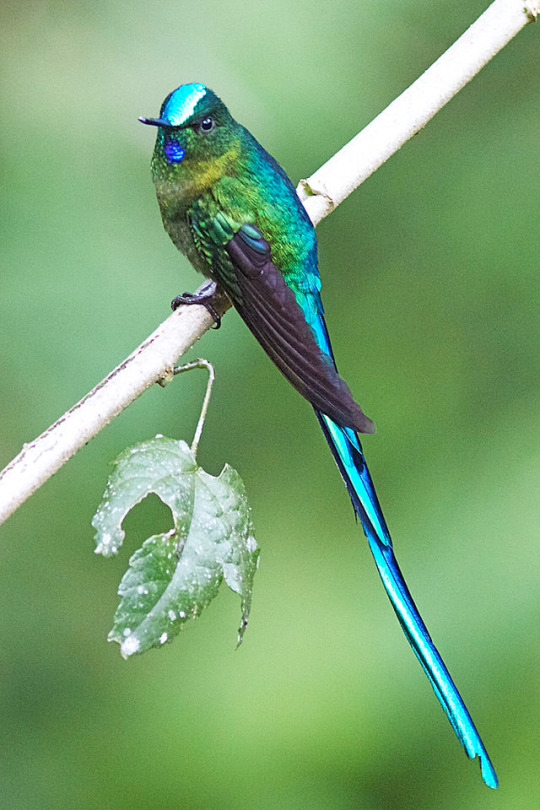

Long-tailed sylph (Aglaiocercus kingii)
353 notes
·
View notes
Text
More Gacha World Redesigns

Kuku
-Part of of the gardening club (joins cooking club after events of main game)
-Her boss battle would be in the garden
-Lower big tails and more black in her design

Cheery (Mei)
-A gymnast and also part of the health committee
-Gyaru
-Lighter hair and brown eyes for a softer look.

Frost
-Performer, mostly uses snow animals and snow magic
-A hint of light green to even out the white and blues I used
-One long ponytail rather than two short ones.

Nekohime (Princess Elena)
-More Lolita elements
-A higher hairstyles
-The Princess of gacha kingdom (lightvale kingdom)

Sylph
-More flowy clothes
-Hints of yellow, white, and pink
-Darker green hair and brown eyes.
22 notes
·
View notes
Text
La part du Roi.
When I ask to the King who he is and why, he answers "my people". When I tell the King that I will return what belongs to him, he does not answer "thank you" but once again "my people". Long Live to the King !
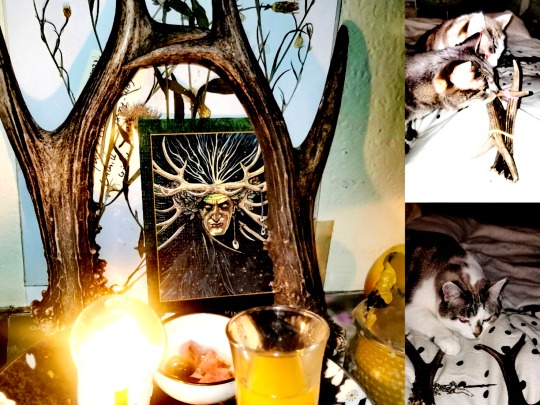
" What a hapiness this must have been 70 or 80 years ago and upwards, to those chosen few who had the good luck to be born (...) when the whole earth was so overrun with ghosts, boggles, bloody-bones, spirits, demons, ignis fatui, brownies, bugbears, black dogs, spectres, shellycoats, scarecrows, witches, wizards, barguests, Robin-Goodfellows, hags, night-bats, scrags, breaknecks, fantasms, hobgoblins, hobhoulards, boggy-boes, dobbies, hobthrusts, fetches, kelpies, warlocks, mocl-beggars, mum-pokers, Jemmy-burties, urchins, satyrs, pans, fauns, sirens, tritons, centaurs, calcars, nymphs, imps, incubusses, spoorns, men-in-the-oak, hell-wains, fire-drakes, kit-a-can-sticks, Tom-tumblers, mech-dicks, larrs, kitty-witches, hobbly-lanthorns, Dick-a-Tuesday, Elf-fires, Gylburnt-tails, knockers, elves, raw-heads, Meg-with-the-wads, old-shocks, ouphs, pad-foots, pixies, pictrees, giants, dwafs, Tom-pokers, tutgots, snapdragons, sprets, spunks, conjurers, thurses, spurns, tantarrabobos, swaithes, tints, tod-lowries, Jack-in-the-Wads, momos, changelings, redcaps, yeth-hounds, colt-pixies, Tom-thumbs, black-bugs, boggarts, scar-bugs, shag-foals, hodge-pochers, hob-thrushes, bugs, bull-beggars, bygorns, bolls, caddies, bomen, brags, wraithes, waffs, flay-boggarts, fiends, gallytrots, imps, gytrashes, patches, hob and lanthorns, gringes, boguests, bonelesses, Peg-powlers, pucks fays, kidnappers, gally-beggars, hydskins, nickers, madcapas, trolls robinets, friars ' lanthorns, silkies, cauld-lads, death-heearses, goblins, hob-headlesses, buggaboes, kows, or cowes, nickies, nacks, necks, waiths, miffies, buckies, gholes, sylphs, guests, swarths, freiths, freits, gy-carlins, pigmies, chittifaces, nixies, jinny-burnt-tails, dudmn, hell-hounds, dopple-gangers, boggleboes, bogies, redmen, portunes, grants, hobbits, hobgoblins, brown-men, cowies, dunnies, wirrikows, alholdes, mannikins, follets, korreds, lubberkins, cluricauns, kobolds, leprechauns, kors, mares, korreds, puckles, korigans, sylvans, succubuses, black-men, shadows, banshees, lianhanshees, clabbernappers, Gabriel-hounds, mawkins, doubles, corpse lights, scrats, mahounds, trows, gnomes, sprites, fates, fiends, sybils, nick-nevins, whitewomen, fairies, thrummy-caps, curties, and nisses, and apparitions of every shape, make, form, fashion, kind and description..."
-- Excerpt from K.M Briggs, who herself quotes an obscure folklorist in her Dictionary of Fa*ries. + merci mon ami @sensu-stricto encore une fois!!!
8 notes
·
View notes
Note
Ok, this is me being bored, so here we go, what I would do as Mother Spore's origin as Grian and how they turned to Mother Spore (based on the original post about Mother's origin here: https://www.tumblr.com/sporelings-au/722568401712791552/mother-spore-mother-spore-is-an-ancient-being?source=share )
In the beginning they were born of the wind, bird song, and the wild magic, a Sylph, a Hyster Sprite. He had once been part of a flock of many protecting children against horrid parents, even to the point of on occasion bringing young ones to fae mounds to be adopted and saved from their horrid homes. Their name back then was Grian, and they were the main voice of their flock, taking the form of a human male sometimes to spoke or tell off humans, though never for long and always keeping some part of their bird form. That was, till those who watched and hunted came. They didn't know in the beginning they would destroy the flock, the purple robed ones only watched them from afar in the beginning, enough so that the flock stopped seeing them as a threat. Then members of the flock started dissapearing and the flock started becoming more cautious, yet more still disappeared till the few who were left realised the truth. The watcheres were fae hunters, and good ones as well. So good in fact that only they got away in the end with the hunters on their tail as they soared through the skies, taking on a more human form eventualy like the elves and other fae as they tried to hide in plain sight within villages. Yet, despite their hard work they were still found and the villages ran them off with the hunters following behind.
Till the day they managed to loose them on a fae island filled with mushrooms and decay. They found the core of the fae relm, a fae of rot and decay who left behind their magic to protect any who were on the run from hunters. And there they stayed, building a large home (a mansion) on the island with wood they carried over from the mainland. The core of the island didn't seem to mind, on occasion it would even touch their mind and magic in inquiry and they would answer. And their mischievous side occasionally led them to scare the creatures on the near by main land, especially the grown humans who eventually came to fear them to the point of putting a bounty on their head.
One day though, the watchers finally caught up, and they had no where else to run.
The watchers injured him, what should have been fatally, but the island core reacted and combined it's self with them. The mycelium of the island pored into their wounds, scealing them in their wake as they and the island became one and for the first time ever they fought back with wild abandon against the humans who had hunted them for ages. The spores they released infected the men and slowly started killing them as they attacked and scared off the men from their island. At which point they went into hiding as they put up barriers of spores circling the island. Those that tried to attack them in their new home in the beginning were attacked mercilessly, till the point it just became a game to them.
As time went on they forgot their name, their beginning, and their fear of humans other then an underlying maliciousness to the adults and a lasting care for the young ones. They started going back out on occasion to toy with humans on the mainland, gaining a new name from the humans in the form of "Mother Spore". Which they were fine with, they had long since forgot their name and a new one was needed, after all names were power. Myths started to spread about them and their island, and that was fine with them.
They may no longer be what they use to be, but they were now the eternal protector of their island, and perhaps one day they could gain new fae or creatures to join them and they could expand their realm and gain recognition as someone/thing not to mess with.
:O Woah thats interesting
love the idea that mother was some sort avian that was in a flock before turning into what he is now.
for the hunters hunting her part, that gave me an idea that they were hunting him for his wings. and the insect, fairy like wings that mother have now are not hers, but a gift from the mushroom island after the hunters injured her and chopped off his wings (would be morbidly cool if they killed him and the island brought her back to "life")
like to think that the wings mother have now cant let her fly very fast and high up into skies like how her old wings would have
and that mother misses that feeling of wind hitting his face as he soars through the sky with ease very much
anyways, tq mx biologist for the delightful insight :>
101 notes
·
View notes
Text

[https://www.inaturalist.org/observations/111747263] Long-Tailed Sylph || Aglaiocercus kingii Observed in Colombia Least Concern in location of observation
#hummingbird#birds#nature#wildlife#photography#air beast#who cooks for queue? who cooks for queue all?
12 notes
·
View notes
Text
Bosses in Harmony of Dissonance
Giant Bat (Marble Corridor A): mandatory for the Worst/Best Endings. The game allows you to skip it very easily, but it turns out that defeating the Giant Bat lowers the drawbridge that leads to the courtyard, in both castles. At the end of the game, you need to go there in Castle B to retrieve the Rib of Vlad: therefore, the Bat is only optional if you are going to defeat Maxim in Castle A, netting you the Normal Ending.
Living Armor (Shrine of the Apostates A): mandatory. It guards the Lizard Tail, which allows to slide.
Skull Knight (Skeleton Cave B): mandatory. It guards the Sylph Feather, which allows to double jump.
Golem (Luminous Cavern B): optional. It guards the Walk Armor (obtainable after getting the Griffin's Wing) and the Yellow Stone, which have limited utility.
Minotaur (Castle Top Floor B): optional, but highly recommended. It guards the Wind Book, which gives you some of the best spells in the game.
Devil (Sky Walkway A): optional, but recommended. It guards the Night Goggles. While it is hard, it's possible to traverse the dark room leading to the Aqueduct of Dragons without them. Speedrunners tend to skip it.
Giant Merman (Aqueduct of Dragons A): mandatory. You need to go through it to connect the Aqueduct of Dragons to the Clock Tower. This is important in Castle B, as you need to go through the unlocked gate to solve the puzzle that leads to the Crushing Stone.
Max Slimer (Clock Tower A): mandatory. You need to go through it to reach Death and progress the plot.
Peeping Big (Clock Tower B): mandatory. You need to go through it to exit the Clock Tower.
Legion (saint) (Sky Walkway B): optional. There is nothing stopping you from taking the long way and go through the Aqueduct of Dragons if you wish to circumvent it. It's inconvenient, though.
Shadow (Sky Walkway B): mandatory. It progresses the plot and gives you Maxim's Bracelet, with which you can access the Castle Top Floor.
Pazuzu (Castle Top Floor A): mandatory. It progresses the plot and allows you to connect the Castle Top Floor with the Chapel of Dissonance from the other side.
Minotaur lv. 2 (Castle Top Floor A): optional. It guards the Steel Tip, which gets soon outclassed by the Platinum Tip.
Legion (corpse) (Skeleton Cave A): optional. It guards the Cipher's Charm, which has limited utility.
Talos (Luminous Cavern A): optional, but recommended. It guards the Skull Key, which unlocks the two doors that connect the right and left sides of the castle (you need the Griffin's Wing to reach it, though). Personally, I found the Skull Key limited in its utility as it comes too late into the game, far less useful than the Lure Key, but it makes exploring easier.
Death (Luminous Cavern A): mandatory. It progresses the plot and he guards the Griffin's Wing, which allows you to high jump.
Cyclops (Shrine of the Apostates B): optional. You don't even need to connect Entrance B with Shrine of the Apostates B. While you need the Crush Boots that are found in the connected Wailing Way B (no matter the ending you want: either you destroy the ceiling of Castle Top Floor A to open the center of that castle, or you destroy the ceiling of the tower in Entrance B to collect the Rib of Vlad), nothing stops you from returning the way you came.
(Related: the areas that can be skipped are Aqueduct of Dragons B, Chapel of Dissonance B, a good chunk of Castle Treasury A, Room of Illusion B, and Shrine of the Apostates B. Marble Corridor B can technically be skipped if one enters the Wailing Way B from the Entrance and progresses backwards until the Crush Boots, but it's inconvenient)
#castlevania#akumajou dracula#harmony of dissonance#a post that is mainly useful to me lol#but i found an interesting low level guide on gamefaqs#in case one wants to speedrun the game or make it more challenging#so there you go. a lot of this game's content is completely optional#kind of like in sotn lol
6 notes
·
View notes
Text
pollen, chapter 6 tags: fem!reader, reader has a personality, mind-fuckery, non-consensual kissing a/n: it's about 8.5k words. thank you all for your patience. read 1-5 HERE.
The thickets of the Eastern Shroud are labyrinthine. Tangles of bramble and clusters of thistle seem to dog your every move as you stumble through the brush. Whatever path you had been following is lost to you now. You’re not sure how long or how far you have wandered.
The thick canopy makes it nearly impossible to tell whether it is day or not. You have to squint to catch a few thin, silvery beams of moonlight, and they don’t even reach the forest floor. Instead, the ground is illuminated by large bulbous flowers and mushrooms which sport an unearthly glow. Some of them even seem to breathe, exhaling clouds of spores which you’re careful to keep your distance from.
The noises of the forest are suddenly cut through by a round of loud, whooping cheers. You rush towards the sound, past bundles of giant flowers, under and over stray branches and thick vines. Your heart thrums in your ears as you break through the treeline, stepping foot into a wide open clearing.
What first draws your attention is the long table, nearly large enough to touch both sides. It's draped in white, pearlescent cloth. Plentiful platters stacked sumptuously with scrumptious seeming snacks line the surface from end to end. Puffy pastries are unceremoniously snatched by Sylphs and Moogles. It’s a massive gathering of them, more than you have ever seen at once. Yet, most seem to pay you no mind, even as you gawp openly. They’re more interested in each other, their chatter already rising to a dull roar. They pour tea into mismatched cups and down olive-colored bottles of swill, lost to their own revelry.
You can’t entirely recall your reason for being here, but you are almost certain it has nothing to do with this mysterious trouvaille.
Just as you turn to exit, however, a soft voice calls out from close by.
“Wait!” A Sylph of pinkish hue floats frantically towards you, looking awfully haggard. The disheartened slump of their posture makes them look like a puppet on limp strings. “Don’t go! This one cannot remember the last time we entertained a human guest!” They plead. “This one’s name is Lixio—delighted to make your acquaintance!
You frown. “My apologies, but I have business elsewhere.”
“And it can’t wait? Even for a few moments?” Lixio pleads. You hesitate. “Only a few seconds, even! Mixia and Xixia will not believe this one if this one tells them a human attended the party! Stay long enough for others to witness your presence, at least!”
Mixia and Xixia are this sylph’s friends, you hazard a guess. As desperately as you would like to get back on track and accomplish whatever you had come here to do, fostering amicable relations with the sylphs is crucial to keeping them peaceful. Gridania is already beset by the Ixal and the constant, looming threat of Garlemald’s invasion. You frown.
“I won’t be a very entertaining guest,” you inform them.
“It is the host’s humble duty to entertain,” Lixio chirps. “And you have already captured this one’s most vested interest!”
“You’re putting me on.” You accuse them flatly. They give a mock-gasp, pressing their hands to their cheeks in faux-astonishment.
“This one would never lie about something so important! You would have been shown the door without so much as a toodaloo if you were not so interesting!” they scold, turning around and beckoning you. “Come, come! This one spies an open seat just for you!”
For a reason beyond you, you stumble in tow, through the dark purple grasses and glowing patches of fungi. Lixio leads you to the tail end of the table, where another sylph is facing down two moogles, body shaking with rage as she shrieks.
“Such indolence! This one should banish you to the bogs! A hundred years of the mossy ones sneezing upon you!” they seethe.
“Our deepest apologies!” the moogle clad in a black, pointed hat shouts back above the noise. Several of his fellows at the table’s other end clink their bottles together. “We will replace it at the earliest convenience!”
“Meaningless! The party is happening now!” the sylph cried back in dismay. The moogles offered no response, another coming to tug the both of them into the dense crowd. Staring at where they had once been, you can’t help but take note of the way the black edges seem fuzzy and writhing in ways most mysterious.
Towering pitcher plants of violet hue spit sparkling pollen clouds into the air above the side of the clearing where you’re seated. You’re not familiar with the species, but you know enough to not trust any of the region’s mysterious flora. You should move, but a steaming cup of tea is unceremoniously shoved in front of you.
“Made from the best milkroot in all the Shroud!” Lixio crows with no small amount of pride. You swallow, observing the deep rosen liquid with no small amount of skepticism. Pink petals float on the liquid's surface.
“I appreciate it, but I’m not thirsty.” The corners of your lips twitch into what you hope is an appeasing smile. Is not being thirsty a good enough excuse to turn down a drink from your self-declared host? Should you have said you’re allergic? Lixio doesn’t seem to appreciate your refusal, little face scrunching up.
“It is most impolite to refuse your host’s hospitality,” Lixio fumes. Your lips press into a thin, straight line at the shrill pitch of their voice. With each moment, your tolerance rapidly dwindles. The cute charm of the sylph wares off with their newfound brattiness. It is one thing to be patronized by primals and Garlean commanding officers. It is entirely another to have this brussel sprout of a creature attempting to scold you. Why did you humor them at all? The voices around you grate your sensitive ears more with every passing moment, nose growing expeditiously agitating when combined with the bright luminescent colors which crowd every corner of your vision.
“I apologize,” you reply tersely. “But I am not comfortable—”
“Not comfortable!? What else must be done to please you?” Lixio inquires. They lean forward, into your space. One of their little arms knocks into the teacup they dropped before you. Several drops of the rosen liquid splatter onto the tablecloth.
A shriek splits the air.
“You have ruined this one’s precious dining cloth!” the sylph who was tussling with the moogles mere moments ago turns their attention to your gracious host. They descend upon your gracious host, seizing and pushing Lixio by the shoulders. If not for their innate ability to float, they would have toppled out of their chair and onto the ground. “Ungrateful! Ungrateful, all of you are!”
“Fixia!” Lixio cries. “This one is sorry! This one will clean it—make it look all new and shiny! This one swears!”
“No! This one has had it with lies!” Fixia snaps, curling their tiny, leaflike fingers into the stained cloth. “No more! No! More!” With a strength belied by their slight frame, they pull at the cloth’s edge—and the entire table is upended. Porcelain flies into the air and shatters, drinkware clanging into sterling silver forks and spoons. Pale pastry cream slaps onto dry earth and dark dark grass, tea of scalding temperatures soaking the earth and splashing onto several, unfortunate bystanders.
They shriek and howl, the crowd thrown into immediate disarray. The fae folk dash and fly in all different directions. You slip away in the height of the panic, grateful to be seated so close to the thick treeline. The sounds of the chaos are soon in the far distance. The bright lights halo your silhouette in a smattering of kaleidoscopic color, fading in intensity the further you stray, diving back into the wood with less certainty than you had before the disastrous party. You hadn’t known Sylphs and moogles to mingle so freely. Perhaps they’ve been driven to cooperate by recent threats to the Shroud?
A matter to contemplate later, you decide. You can’t stray from your goal—which happens to be remembering what’s driven you out here in the first place.
In the distance, a river rumbles underneath a curved, wooden bridge. Vines of ivy and purplish leaves intertwine over the suspiciously thin railings. This is the deepest you’ve ever delved into the Eastern Shroud, often put off exploring by the hostile, tempered Sylphs which inhabit the wilds in great abundance. Whatever brought you here was deemed worth the trouble, but your memory remains out of your grasp. Perhaps Meteor would—
You freeze. Hardwood gives way to soft, loamy grass.
Meteor. Ardbert. Where are your teammates? How could you have forgotten them? Revulsion and white hot alarm begin to churn your stomach as you comb through the possibilities, but your thoughts come slow as molasses. Think—think, god dammit! You tap your fist into your temple as if trying to knock your head clear of whatever clogs it. It doesn’t work, of course, leaving you with a sore spot and the paralyzing dread of knowing something is amiss.
You stumble forward, rib cage throbbing dully as one urgent breath shudders out of the next. The air feels thick, like you can’t get enough of it at once—and soon you’re grasping in the dark, struggling to keep yourself upright.
It’s not a horrible place to collapse, you think through the haze. Maybe resting for a while will do you some good, maybe you’re too tired to think.
You don’t realize you’re sliding down until your knees knock into the dirt. Surely, that too is fine. Surely, no bandit or other neerdowell would venture this deep into the Sylphlands, too terrified of fae magic and ferocious flora. From here, though, it's not too terrible. What you can see from underneath lowering eyelids is all beautiful in a strange, otherworldly manner. Dark purples coalesce with bright, pink petals and white shroom caps which glow soft in the peaceful dark. Yes, there will be plenty of light when you wake.
Someone calls your name. You huff and burrow yourself between the roots of the tree, bark scratching the thick fibre of your robes. You hardly mind the cold, damp bark on your cheek. Just a few minutes. Just a few—
Another shout, closer this time.
Mere a few winks of peace—
A broad pair of hands seizes your shoulders and shakes, nearly throttling you against the trunk. When your eyes snap open, it's Ardbert’s concerned countenance which greets you.
“Are you with me?” he asks, leaning close. You can count his every eyelash. Relief crashes over you, nearly hard enough to render you breathless. Ardbert. You blink several times, just to make doubly sure that this is no cruel illusion borne of Sylph magic. But you reopen your eyes and he is still crouched in front of you, familiar face wound deep with concern.
“I’m up, I’m up—” you stagger to your feet, if only to avoid another jostling. His gloved hand wraps around your forearm, carrying an alarming majority of your weight. Too often, you forget just how strong your teammates are, just how easily they could snap bone if so prompted. “Are you alright? Where have you been, this whole time?” you gather your wits enough to ask. The adrenaline shakes away the worst of your weariness.
Ardbert releases you with a haggard sigh, dragging his hand down his face.
“I should be asking you all that,” he begins, exasperated. “Do you have any idea what would have happened to you had you actually fallen asleep?”
“No, do you?” you rub a hand down your face, bleary eyes peering over your fingers as a beat of silence passes. And then another. And then—
“Well, no—but knowing the beasts which skulk around here, it would have been nothing good!” Ardbert blusters. “Now, come on. We have to find my brother.”
“You haven’t seen him?” you inquire. You have to jog a few paces to reach his side before he mellows into a slower stride, exhaling a long suffering sigh. You’ve known him long enough to peer beneath the hardened veneer he wears in the face of all challenges. He’s playing tough, but he’s just as lost as you are. The purple under his eyes is more pronounced than usual. He hasn’t been getting enough sleep. After all of this is over and solved, you’ll procure a tea or tonic to help. And maybe something for his flushed complexion.
His cheeks are a ruddy red, a thin sheen of sweat gracing his visible skin. You could have dismissed it as exertion, likely from roaming wild and reckless around the whispering wood, but the blush has only deepened since you began walking. Petal pink lips part around semi labored breaths.
“No. I haven’t,” Ardbert admits.
“Do you know how long ago you were separated? Did you come in together? I can’t remember a thing.” you confess. You’d not admit it aloud, but having another at your side—having someone to confide in and question is a reassurance you didn’t know you would miss. He’s firm and warm at your side, not as tall as some but still made steep by his warrior’s armor.
He doesn’t answer. You glance over at him a second time. Still flushed. Feverish. Perhaps he’s allergic to some of the local flora? All manner of suspicious plant and flower populates the darkened boughs of the Twelveswood—each bearing their own fruits and pollen. Gods only know what those spores will do to a person.
“Ardbert? Are you alright?” you press gently.
“I’m fine. I just want to get out of this hellhole,” Ardbert insists brusquely, frown deepening. “Worry about yourself, for once.”
“I’m not the one who’s red as a tomato right now,” you huff, but otherwise keep careful to curb your sass. Quarreling will serve you no purpose in a place so hostile, you remind yourself.
“It’s as humid as Ifrit’s arse out here,” Ardbert replies in kind, face twisted into a scowl. “And you were about to pass out before I found you—that’s worth more concern than a little bit of heat.” He argues, and you feel a near nauseating wave of deja vu was over you. It’s the beginning of a familiar dance, the steps of which only you two know. You don’t have the energy for it, right now.
“If you say so. But if you start feeling off—”
Ardbert makes a rough, irritated sound. “You always do this,” he says, exasperated and angry, voice gravelly with the intensity of the emotion.
“Do what?”
“You always get after both of us for not licking our wounds enough—but you never take proper care of yourself!” It’s an abrupt frustration that comes out of nowhere, like a flame jolting to life on a match. It reaches beyond the routine arguments you’re so used to. It weaves into the surrounding aether, not unlike the potent rage he involves on the battlefield. Pain cracks through the passion, the bottom of his lip beginning to wobble. He stops and turns on you abruptly.
“What!? Where is this coming from!?” You stumble backwards, nearly tripping over your own coattails in the process. “You can nag me all you want, but let’s just focus on getting out here for now!”
He scoffs. “Really? Going to lecture me on focus when I just found you curled up in the dirt?”
“Oh, come off it! I was exhausted! I’ve been through a lot today, Ardbert, I don’t need you adding onto it—”
“Why not? You seem to have no problem adding everyone else’s rubbish onto your plate!” he snaps.
Your eyes go wide as his shadow envelops you. “How do you think that makes us feel!?” Sticks and deadened grass crunches underneath his heavy leather boots as he approaches. “We watch you wring the near life out of yourself! Constantly! You forget to eat! You refuse to sleep!” He looms close. You don’t even realize you’re backing up until you bump into a gnarled trunk.
“Useless! It makes us feel useless!” he nearly snarls, fist pummeling into the trunk. You flinch, withering backwards. The wood splinters beneath his gauntlet, pieces spat out onto your cloak. “We can’t ever help you because you keep letting your goddamn pride get in the way!”
“I’ve never asked for your help!” you splutter, fists clenching at your sides. Animal fear and righteous anger wrestle for dominance in your churning gut.
“And that’s the entire problem! Your head is so far up your arse that you can’t even see when you need help!” he continues, voice pitching into a desperate shout. His chest is an iron wall, heaving with each labored breath. A wall in front of you, his arms bars. He’s right, you realize, and that’s the most irritating part of it.
You can’t muster up an adequate reply, too busy searching for an opening. This has gone too far, beyond your typical quarreling. He’s not even a film away, face close enough to note each fine indent of his scowl. The warmth of his body seeps through his armor, even though it really shouldn’t—defying all reason to your muddled senses. The cloying heat that makes it harder to think, harder to wriggle away.
Broad palms cup your jaw. His fingers spread across your cheeks as he forces you to look up—up into glowing, pink eyes. Something in you shatters, then, utterly jarred by the unnatural neon you’re faced with. Only now do you clock how wrong all of him is, how the actors of this play aren’t quite fitting their roles. You open your mouth—to say what you do not know, but the words never quite come. They die on your tongue, because—
He’s kissing you. With warm, soft lips, pressing in and drinking deep of you. A hot tongue pushes into your gasping mouth, chases your own even as you writhe and push at his chest. Faintly, you’re aware of your hand around his wrist. You claw and scramble for purchase on his leathers, attempting to pry away from him.
The difference in strength is too great, and the air is growing too thin. You’re making noise, little whimpers and whines which he swallows, steals them alongside each dwindling breath. Your consciousness begins to fade, black crackling at the edges—and it’s that which jolts you back into shocking awareness.
You cannot fall here. This is not your Ardbert.
Blind panic surges through your veins, levin crackling underneath your skin. The atmosphere trembles, the very fabric of the cosmos beckoned to your aid. A silvery sphere of raw aether sparks into existence behind him. The nearby foliage pulses, and is drawn into it alongside your companion’s devious duplicate. The fake is torn from you with an enraged animal sound.
You turn on foot and dash madly into the woods before the spell fully triggers, blowing everything it's drawn within to smithereens. You fumble over jutting roots and fallen branches, pulling lungfuls of precious air into your howling lungs. The world flies by in shadows of green and purple and brown, fluorescent mushrooms and flowers puffing clouds of suspicious spores. Only when you are alone do you at last come to a pause—bending over to gasp for much needed air. Your sweaty palm presses up against bark, wincing at the coarse bark against your slicked skin.
The situation is more severe and incomprehensible than it initially appeared. Something in the wood plays cruel tricks on you, to wear the faces of your companions. You’ll never forgive who is responsible, whether it be the Sylphs, the Moogles or any other manner of frivolous forest creature. You’ll slay them yourself, you decide.
With that vow made, you regain your breath and stomp back into the thickets, heading towards the gaping mouth of another treeline. Halfway, you pause, a sudden thought striking you.
If Ardbert had been a doppelganger, were either of your partners ever truly here in the first place?
The panic cooled into listless paranoia as you continued to roam. Desperately, you comb through every corner of your mind for some clue, some context as to why you arrived here in the first place. Your probing turns up frighteningly little. You can recall disembarking an airship and meeting with an official at the Adders Nest. The air was tinged with ripe lilac and honeysuckle until you took the ferry east, over murky waters and through verdant masses of algae. The skiff’s bow cut through the tranquil lake like a knife through warm butter.
That’s all you’re able to discern. The finer details pull away when you reach for them. Something, or someone, has purposefully obfuscated your memories. And all you can do is lumber exhaustedly through their crafted labyrinth, out of options and tools and sapped of every after casting impulsively and without a focus.
A flicker of familiar scarlet teases at the edge of your vision. You snap your head towards it, fears temporarily forgotten. Your gaze darts around in the dark, only to find more of what surrounds you. Deadened trunks and berry purple leaves.
Your shoulders slump, more exasperated with your own eyes for playing tricks on you than affected by the vision itself. A Warrior of Light can’t quake and crumble at the slightest of provocations. You’ve dealt with worse than this, fought stranger foes and outwitted politicians and enemy generals and gods alike. If you can’t surmount this—
A bell-like laugh echoes up and down the wood, a sound you never thought you would hear again.
“Come now, hero! Are you really going to let me run off a third time?”
Familiar agitation sweeps through you at his mocking lilt. It feels nostalgic, in a way, but you know better than to chase a dismembered voice off in the distance. No matter how achingly familiar. You turn away, and you keep on walking—
“Really? You would ignore me after all we had together?” his voice is in your head, now, flat and disappointed. You whirl around, trembling fist clenched, but your dulled reflexes are but a moment too late. You’ev shoved backwards, and where you swore there had existed solid should is instead a slope covered in sticks which snag and leaves which crunch loud underneath your tumbling body. A pained shout wrenches from your chapped lips, flank landing hard on the dirt.
You scrape your hands on bark and stone as you pull yourself to your feet. A mere film away is a tangle of bristling brambles. Count your blessings where you can find them, you suppose. Your hands raise to brush the clumped soil off your person. They never get that far.
The dark, still edge of a familiar blade tucks underneath your chin. You can’t remember seeing or hearing anyone approach, but you have often noticed that Meteor moves quieter and more discreetly than anyone in armor has any right to. But he’s keenly aware of that, too. He always makes noise on purpose, just to let you know he’s coming. To not scare you.
But not this time. His eyes are wide and wild, hair knocked into tangles, dirt and blood smudged across his face. The crimson is slick with its freshness. He’s a terrifying vision, hunched above you like a wolf looms over a wounded lamb.
“Meteor,” you rasp, quietest you have ever been, “It’s me—” you find the stones to continue after a long moment, spent in sheer disbelief that he would raise his weapon at you. His face twitches, but the eerie stillness there remains. There’s something anguished in his eyes.
“I’ve heard that, before,” he says ruefully, breathing heavily. “You won’t fool me. Not again.”
“You—what are you talking about—” you stammer. Realization crashes into you a moment later, fast and brutal as a Coerthan gale. “How many of me have you seen?” you can’t help but ask, swallowing against the pinprick of his blade.
He licks a bead of sweat from his lips. Mindlessly, you track the movement.
“Two, now. Ran them both through,” he admits, equal part confession and threat. There’s no wobble in his voice, though. No regret. Sympathy juts through the haze of your fear.
“I’m sorry,” you murmur. “That you had to—”
“No. Don’t even start.” he mutters, shifts closer.
“I’m real, Meteor. I can prove that I’m real,” you fumble backwards, pulse rumbling in your ears. Your back meets the unyielding stone of a nearby ledgeface, trapped between it and his unforgiving steel. “Ask me something only I would know!”
Meteor’s jaw ticks. “The second one said the same—and they were right,” he swallows. “—when they answered.”
“Then—Then I can just leave!” you exclaim, unable to keep the panic from your voice. You can’t even begin to fathom the implications of what he’s disclosed to you, not while the edge of his blade inches forward, kissing the column of your throat. “I won’t show my face again. I swear it!”
The space between his thick brows scrunches, for the first time breaching his glazed, wild expression. The sword wobbles against your skin, threatening to break it, before he heaves a great sigh and lowers it. You slump against the craggy wall, erupting into a series of sputtering, shaky breaths. You must make a pitiful picture, but the relief is so palpable that you can’t bring yourself to much care.
He remains there, looming and still as a statue, deadly weapon still clutched in his hand.
“I’ll—I’ll just be doing, then,” you assure him once you’ve regained your breath. It kills you to leave him here, distressed and alone, but you can’t solve this conundrum if you’re dead. You’ll have to come back for him, and in the meantime hope he isn’t visited by any other spectors wearing your face.
Though, maybe you should worry more for yourself. The phantom feeling of Ardbert’s hands sticks cold to your skin, a poignant reminder of the danger that lurks.
“There’s an Ardbert imposter running around,” you inform him, wincing as you pull yourself to your feet. A piercing ache throbs in your left side. No doubt it’ll be a nasty bruise, later. “I know you don’t believe me I’m real. I just thought you should—”
His hand cups the underside of your jaw, the cool metal of his gauntlets firm against your overheated skin. The clawed tips prick your cheeks. You blink stupidly, numbly as he seizes you, lifts your head to meet his imposing, keen gaze. He’s analyzing you, you think, searching for something you cannot quite name. Your pulse thrums against his forearm, in your throat, skin brushing against the metal with each throb of blood through the vein.
“Meteor—” you rasp, frozen in place by the weight of his attention alone. A beast brays somewhere in the far distance. The forest squirms and shivers despite a lack of wind.
His eyes shut. He exhales, trembling. He’s testing your measure, yet to what parameters you do not know. You can only linger in the space between the seconds, awaiting his judgment.
He opens his eyes. “You’re real,” he murmurs. His thumb strokes across your lower lip, careful to mind his claw. His eyes flutter shut, brown lashes tucking against pale cheeks. “I’m sorry—”
“It’s fine,” you reply automatically, rising to your feet. You know full well that he would never raise arms against you unless under significant duress, unless out of his mind.
“It isn’t,” Meteor replies coolly, raking a hand through his hair. “But now isn’t the time.”
You don’t reply nor do you give into the sweet relief his presence brings. He looks like he’s struggling with what else to say, lips pulled into a straight line.
“So, let’s pool our information,” you speak up, just to spare him the agony of his own thoughts. There’ll be plenty of time to wallow in his guilt later. You don’t need any more platitudes or pleas for forgiveness—the moment has passed and neither of you should live in it.
Meteor heaves a sigh, “After we arrived in the Shroud, a fog settled over the entire area. I could hardly see my own hands—”
“Forgive me, but why did we come to the Shroud in the first place? I…” you chew on the inside of your cheek, warmth rising to your cheeks. The idea of you forgetting the specifics of a mission is completely out of character, and horribly humiliating. The question gets stuck in your throat, stubborn pride warring with your own rampant need for context, for information. “I can’t seem to remember.”
“We…” Meteor pauses, blinking. His gaze crawls from you, eyes glazing as he stares across the empty clearing. “Came to gather milkroot.”
“...Milkroot?” your eyes narrow. This is a poor time for jokes—the notion that the Scions would send you here to do chores is laughable, but Meteor nods. Dead serious as he’s ever been.
“Over the past moon, it’s grown out of proportion. It’s making the tempered Sylphs come out from deeper in the wood.”
“Alright. So you happen to know where this particularly intrusive patch of milkroot is?” You’re still not sure if you believe him. And if you do happen to believe him, you’re still miffed at being deployed for pest control, of all things. You’ve felled three primals and beasts of equal strength. You are above getting on your knees in the dirt to clean up some random mess.
“I do,” Meteor nods. “But the thicket… It's hard to navigate. I’ve already been lost twice.”
“I can only imagine,” you mumble, sympathetic. “Well, given it's our only lead, we can head there first. Does that sound alright?”
And Meteor nods, by far the most well-behaved tank you have ever met, both in and outside of battle.
He does, taking you through winding pathways, skirting along the very edges of the darkened deepwood. In the distance, you spy purple sylphs and tall plants with wide, spikes maws. Their broad stems rise and fall as if breathing. Clouds of poison expel into the air with each breath.
“Meteor—” you say, and then swallow. The ambient aether pulses around you—and suddenly you are in that far off distance, surrounded by them on all sides. The air is sickly sweet and sparkling ripples of bright purple glisten through the gloom in undulating waves. You stagger, boots scuffing on the dark dirt. Everything seems to breathe now. Thick trunks and brambled branches, expanding and shrinking. Your gaze lifts to the canopy.
Meteor says your name. A firm hand clasps your wrist, firm and grounding. Your lungs feel tight, throat constricted. Dazed and unfocused as you are, you manage to find his gaze among the swimming dark. Have his eyes always been so bright?
But it’s not enough. You feel yourself crumple, not all at once. one part of the body after the other. Mere moments feel stretched into minutes, your world condensing to stuttered snapshots. Meteor, distraught. An oversized log up top the slope. A lone sylph, faced away from you. Strands of green and stiff purple grass, which tickles your cheek.
And then, the eerie black.
There is no time between when you shut your eyes and reopen them. A fraction of a moment at most. Your eyelids pry open and you are back on your feet, mid-step.
“Drowsing on the job again, are we?” G’raha Tia says. Your brain stutters, struggling to piece together his presence. It’s beyond jarring. It’s like seeing your smallclothes laid out on the Rising Stones’s Bar. A piece of you, something so close and intimate, dragged out and misplaced for all to see.
He looks different then the last time you saw him. Both of his eyes are blue. His hair is longer, fastened into a thick but wild braid. A greatbow slung across his back is emblazoned with golden accents and striking blue gemstones. One half of his shirt is blue, the other black. The neckline hangs low, the fabric bunched by a red and black sash wound around his waist. Sheathed daggers and miscellaneous pouches hang off two belts slung underneath it. Another is fastened around his thigh. Some of the gold bangles tied round his arm gloves and thigh high boots sport beads in the shape of the sun and stars. A bard, you think.
“I…” you begin, tongue heavy in your mouth. What had he asked of you, again? You blink, attempting to clear away the lingering haze.
“You know how that old saying goes—sleep late and you lose the worm and all that,” he says, eyes glimmering. Playful. “And if I’m not mistaken, this will be the third such occasion in which you’ve missed the goal.”
“The third?” your lips peel into a frown, familiar agitation sparking within you. “What are you counting as the first two?”
“If it truly mattered to you, you would have remembered by now,” his smile turns wry, blue eyes so bright and bitter. Your jaw locks, awareness washing over you like grains broken from an hourglass, sands of time settling heavy and suffocating atop your chest. The anger, the pain, the loss—it tastes coppery.
“It wasn’t my fault,” you protest.
His gaze softens. “You don’t believe that.”
“How would you know? You’re the one who left without so much as a word! You couldn’t even be bothered to leave a note behind, G’raha!” The anger erupts from you all at once, typical restraint worn by the day’s events—the day’s events, you realize.
This isn’t real. G’raha Tia is long gone. This is another cruel illusion conjured specifically to waste your time and demoralize you. You need to leave.
“Why would I write a note to someone who clearly couldn’t stand me? From the moment we met, you made it painfully clear that you wanted no part of me. You only tolerated my presence, as though I were a coworker’s child getting underfoot. You despised me, but you despised the fact that you needed me even more.” Every word drives into you like a rusty prong of steel, wounds just begun to close reopened and stung, skin split and stitches burst. All at once, you feel speechless and small, no better than a child.
“And you never bothered to examine why I behaved in the manner that I did! Did you not once consider that I only wanted to impress the vaunted Warriors of Light!? To prove that I was worthy to stand at your side!?”
“Stop,” you gasp, and it feels like getting sick, the back of your throat for some reason rubbed raw—like you’ve been running a marathon or screaming out your bedraggled soul.
“Perhaps, if I felt I could confide in you, I would have told you. Perhaps you could have convinced me to stay.” G’raha continues, voice soft again. The anger and agony is gone, now. Only the stillness of a soul lost or given up, looking out across the short tale of his life in pensive reflection.
“Perhaps I could have gone on to be an adventurer, too.” His voice is nearly smothered by the sound of wildlife, groans and chirps and howls and clicks erupting around you. The shadows reach out like spindly fingers. Every hair on your body stands on end. Your instincts scream for you to rush forward and shield him from the malignant presence which haunts this horrible, wild place.
Not this time, though. Not for this delusion. Your jaw clenches as the bleak, empty dark encloses on him like a flower’s petals. You stand there, and comfort yourself with the knowledge that this is too a phantasm, a vision spun for the sole sake of your distress.
You blink, and the murky depths disappear. Meteor is standing in front of you, eyes bright and face hard with concern.
“I’m alright,” the words are out of your mouth before you can even think. Automatic, at this point. “We can keep going.”
“I can carry you, if you’re tired.” he informs you. His barely flat delivery makes you wonder whether he’s offering or simply telling you a fun fact.
“You don’t have to. I’m fine,” you sound weaker than you would like, reedier. “And we should both be concerned about the doppelgangers running around. They’re likely Sylph illusions, but simple magicks cannot explain how they knew such intimate details about us.” And about your relationships. The illusory Ardbert’s words had been weighed by honest, clear agony.
“Perhaps the culprit is no mere Sylph,” he suggests.
“Who would it be, then?” you scoff, kicking a large brand off the path, which has started to thin. Up ahead lay another dark bridge, the river churning below. The area leading up to it is no larger than three films across, and populated by several tangles of bramble. It’s little wonder that the tempered Sylphs of the deepwood don’t make their own fortresses. Nature is more than willing to supply it for them.
Meteor provides you with an informative shrug, leaving you to stew with the possibilities. Frankly, you cannot name a single person who would be privy to the innermost workings of your troublesome trio. Most enemies don’t get close enough for a chance at conversation, and most allies are kept at a strict arm’s length. By you, at least.
You shut your eyes for a moment as your mounting headache returns full force, but a moment is all it takes for you to stub your toe on a stray root. You curse, voice echoing up and down the misty boughs.
Meteor looks at you pointedly, head tilting. You glare.
“No.” you say.
He takes a step closer. Into your personal space. It takes all of your healer’s patience not to unleash a volley of crass curses directly into his face.
“No, I’m fine,” you firmly insist. “I don’t need any coddling.”
Meteor looks remarkably unimpressed. “What’s your plan, then? Please, enlighten me.” he says, completely flat. “Wander aimlessly through the woods until you twist your ankle on another vine?”
Your face crinkles like you’ve just eaten a serving of Archon Loaf. Since when has he been… so sassy? So prone to backtalk?
No—it makes sense. Being forced to slay even an illusion wearing his face and speaking in his voice would shake you, likely leave you rattled for weeks. So of course he’s on edge, snappier than usual. You take in another deep breath, count to three, and exhale, willing your tempestuous temper away.
“I won’t lie. I am… unsure of the specifics of our situation. However, I have a few theories,” you lean up against the closest tree trunk and roll your head back, shutting your tired eyes. G’raha Tia comes to you in flashes, blue eyes deep and haunted. You settle for staring at the dark canopy instead.
“We could be inside a sealed space which repeats itself, where elements of terrain are randomly placed to give the illusion that we are genuinely traversing the forest. Such a complex spell requires a skilled caster and a bevy of aether at their disposal. The Sylphs are, for the most part, natural born casters and obtaining the crystals required could be as simple as leading a few unlucky merchants astray from the trodden path.” you finished with a grimace. “A likelier theory is that we’ve been trapped in some kind of dream.
“All three of us together?” Meteor inquires, placid mien betraying no skepticism. It’s a relief that your hypothesis hasn’t been met with immediate disbelief. Some of the tension melts from your body as you open your mouth.
Before you can speak, someone calls to you from across the clearing.
Meteor shifts into a defensive stance, clean steel of his greatsword aimed at the approaching, darkly dressed figure. It takes you a moment to see it, to genuinely sew the embellished black plate, the eyes deep and wide and hauntingly blue. The tips of his ruffled hair kisses the space where his stubble begins.
No, oh gods, no—the forest fades into black nothingness, silent but it must be laughing. Laughing, because you were foolish enough to not anticipate this. The air struggles to stay in your lungs. Your ears pound, your chest thuds with white hot panic, rolling up your spine and forking into the base of your skull. You can’t handle this, right now. You stare numbly at the approaching form of a second Meteor.
You should have expected this. If the mastermind was able to so seamlessly replicate Ardbert, then it is only reasonable to expect the same of Meteor.
“Stay behind me,” Meteor says, quiet yet uncompromising. As if you plan to step in front of the hulking slab of metal he calls a sword. “Leave us alone. We know you’re an imposter.”
His doppelganger, rather than responding to him directly, looks at you instead, concern writ plain across his furrowed brow. Meteor stands taller to block his view of you, black pauldon sheltering you from that pained, beseeching stare.
“You’re as bold as I expected a Sylph-borne simulacrum to be,” the doppelganger begins. He calls your name, then.
“Bold accusations from a shade with no proof.” Meteor rebuffs. “I’ll not warn you a second time. Leave, or your Sylph masters will receive what remains of you in hand baskets.”
Traveling together begets familiarity. Yet, you would never claim to know Meteor’s every facet. Yet, you cannot suppress the wave of wrongness that sweeps through you. It’s a sudden chill. In all the times he has stood firm between you and the enemy, he has never been so verbose. No, he cuts down the enemy before they can even spit a word. The sprout of dread burgeons within you, renders you near breathless as you stare at his back, desperate to get a closer look at his eyes.
The other Meteor calls your name a second time.
“I lack the time to bother with paltry words. You know that.” he says, desperate to be known, to be believed. And it’s true. It’s completely true. An idiosyncrasy that only he would be aware of. You step back, instinctively reaching for a weapon that isn’t there. Your boots scuff the dark dirt, and the Meteor who you’ve been accompanying whirls around. He looks like you’ve knocked the wind out of him, staring at you in disbelief.
“Don’t tell me you believe him,” he says. His eyes are wild and wide with horror.
“I—I—” It’s much more difficult to defend your position when he’s looking at you like that. It’s a look he only fixes you with on the rare occasions that you get a scrape or cut in battle. Scrutinizing and perhaps annoyed, but feral with concern. Like he’d reach his hands inside of you to fix any misaligned inners. Like he’d sink his teeth into the throat of those responsible. All gnashing fangs and frayed bangs, blood and soot and dirt smudged on his cheeks.
You take another step back. Where there was once a blank dirt road, there is—something, something which slithers around your ankle and pulls, sending you tumbling to the earth. You wince at the initial impact, earlier injuries sent spasming.
A few fulms away, you can see him start in your direction, outline of a curse on his lips. He’s lowered his greatsword by a hair, head craned to snatch a brief look at you. But that’s all it takes.
Sabled steel slices clean through his middle. Blood gushes onto the ground. His armor dents where it’s been cut through, gnarled metal groaning as he crashes to the floor—spasming. Bile rises in the back of your throat as you watch his lips open around strained wheezes. Here, in the dim dark, you are forced to confront your worst fear. The life bleeds out of him, the wound too gaping for your feeble aether to mend. You try, anyway, crawling over dirt and twigs to reach him. A clammy palm presses against the cold, cold curve of his chestplate.
The aether sparks feebly at your fingertips. The skin stings and burns but you push through—it is a mere fraction of the rest of the pain you have been put through today, after all. Beaten and bruised, you try and pour everything which remains into his shuddering body. His torso twitches like a fish brought to land. Fervent even now, in the throes of death.
His eyes glaze. He stops moving. He’s looking at you, still.
You choke back a scream.
The body explodes into a sparkling cloud of purple aether, before vanishing altogether. Another imposter, this entire time. Twice now, you have been so thoroughly fooled. You cannot claim to be close friends of either brother, but you know them. You know Ardbert leaves extra tips for bar keepers and inn maids and checks the doors and windows twice each before retiring to bed. You know Meteor only ever haggles in Ul’dah, and that he runs errands for the folk of every settlement and city which you visit. You know when Ardbert is close to lashing out because his jaw locks and he gets this little line on his chin. You know when something is troubling Meteor because he fidgets, most often with his gauntlet straps.
All of that, and still you readily believed their imposters, even made excuses for them! Your hands curl into fists, strands of grass crushed between them. Your eyes stay wide open, the imposter’s last few moments ingrained in your mind’s eye. You will see it every time you blink.
It was a fake, sure, but it still wore his face. It looked at you with his eyes and called out to you in his voice.
Much like the voice that calls to you know. Meteor is wearing a grimace as he makes his way over to you, no doubt disconcerted at having to bring his own doppelganger to the sword.
“I’m sorry,” he says, lips pulled into a disgusted frown. “You shouldn’t have had to see that.” He doesn’t bother asking if you’re alright, because you’re not and you know that much is obvious. You have faith that you look as much of a wreck as you feel.
You swallow, and do not take his hand, because even this too feels wrong. If you were an ilm less wise, you would reason that paranoia from today’s ordeals has set in. But you now know that nothing in this horrible, labyrinthine place adheres to reason or empathy.
A nearby cluster of tall, bulbous flowers glows bright yellow. The light catches on his armor, his sword and his eyes—which gleam that horrible, acidic violet.
“Stay away from me!” you push yourself to your feet and scramble backwards. “I know what you are, now! Stop hiding behind someone else’s face, you spineless wretch!”
It inhales deeply. Patiently.
“You’re afraid, and it’s affecting how you see things,” he coaxes, raising his hands in a gesture of surrender. “There’s no need to be afraid. If you would just let me—” His eyes flash a hot pink. He goes silent, arms dropping back to his sides. His expression loses his desperate candor, glazed and empty. You don’t stick around to wonder why. A searing ache burns at your walk-weary legs, exhausted muscles crying out for sweet reprieve. You heave yourself to your feet regardless, ignoring the stubborn pain. The myriad cuts and bruises you’ve amassed since this all began sting and throb.
You still don’t know what “this” is. You’re still at square one, without a clue or a hope to get you by. All that matters now is getting as far from this newfound imposter as possible. You rush across the clearing, gritting your teeth through the agony.
The imposter says something, then. You’re too distracted to hear, but you can clearly make out the sound of his boots thudding as he gives chase. Animal fear sets your body aflame, bolts of levin dancing up and down your spine. Every heaving gasp burns the back of your dry throat, eyes watering against a sudden gust of wind. You cannot die here.If you were in better shape, if you hadn’t been run so ragged, perhaps you’d be able to claw your way out of this. But he bridges the distance between you with pathetic ease.
“This a terrible shame to lose someone so skilled,” he says. He shoves an elbow into your mid-back, harsh plate slamming into your spine. “You could have served on His Majesty’s court.”
You crash to the ground for what feels like the thirtieth time today, shuddering and clawing at the dirt, feet kicking out as you attempt to delay the inevitable. Oh god, you realize belatedly, deliriously, that this is where you die. In the dark and alone, covered in sweat and grime, last moments spent wriggling in filth like a pig. This is how they will find you—if anyone even does, rumpled and beaten and bloody—no partners to lend you aid or shield you. No one to fret over your wounds or nag you to rest.
Ardbert was right. Black spots swim at the edges of your vision. Behind you, the whoosh of a blade winds through the air. May it be swift, you pray, and shut your eyes.
The blow never reaches you.
The sound of a thousand windows shattering nearly blows out your eardrums. The noise is almost a physical force, erupting from the space only a few fulms ahead of you. Tendrils of blinding daylight reach in as the darkened skies seem to fall to pieces, starlit canopy cracking and crumbling to the earth in crystalline shards.
A blur of brown streaks past your left side, but the enraged roar it makes is familiar enough to make your eyes water with tears unshed. Steel screams against steel. In that instant, you drop. All fight leaves your body, head thunking into the soil. You turn your face to the side to avoid a mouthful of dirt.
You cannot see the full scope of the fight, because a pair of arms circle around your prone body. You’re lifted fast enough to make your head spin, nausea churning in your gut. All you can do is swallow down the acid bile, lest you stain Meteor’s dark plate and leathers.
Instead you let loose a dry, rasping sob. The nightmare is over. You have nothing else to fear. All of the mysteries you have agonized over will be explained in due time.
You fall to pieces. Above you, Meteor’s lips are moving, but you can’t make out a word over the shattering and screaming and thrumming of your traitorous heart. He looks down at you, and you would feel guilty at the abject horror and concern written plain across his face if you were not so, so relieved. You cry, and cry, and cry, not even caring when the points and hard flats of his armor jostle your wounds because he is here and he is real. He is so achingly, endlessly and utterly real.
It is relief, not fear, which blurs your vision and runs down your cheeks. Relief deeper than you ever thought you could feel. So deep that you submerge into it, sinking into the merciful empty of a well-deserved sleep.
17 notes
·
View notes
Text
Let’s turn up the heat because I’m going over the real-life inspirations for all the fire-type starter Pokémon. Here are the links for when I covered the inspirations for all grass starters, all fish, and all non-fish aquatic Pokémon.
Gen I gives us quite possibly the most iconic starter line: the Charmander line. Interviews with the design team have revealed that Charizard was the first of the line to be designed and the other two were designed by working backwards from it. Both Charmander’s English and Japanese name (Hitokage) reference the mythical salamander of European folklore. Salamanders have been associated with fire in multiple cultural folklores throughout Europe, often to the point where their depictions have nothing to do with the actual amphibians. Interestingly, the oldest accounts that associate salamanders with fire comes from Pliny the Elder, who repeated an account their bodies were so cold they could extinguish fires. Somewhere along the line of legends being passed down, salamanders got flipped from repelling fire to living in it, possibly as a result of getting conflated with other mythical reptilians like dragons or basilisks. In the renaissance, the alchemist Paracelsus described salamanders as fire elementals, along with a group of other elemental beings (gnomes for earth, sylphs of air, and undines of water).

(image: an artistic depiction of a fiery salamander. Art by Michael Maier)
In addition to salamanders, Charmander and Charmeleon are given the upright poses and dragging tails of outdated reconstructions of theropod dinosaurs. Charizard is a classic depiction of a western dragon: a winged reptile that breathes fire. Western dragons are based heavily on lizards, with some of the earliest depictions being a dead ringer for monitor lizards. Charizard is said to love fighting, which is reminiscent of how western dragons have been depicted as dangerous, destructive, and even demonic monsters. It is only relatively recently that western dragons have been depicted as anything but evil. Charizard doesn’t have the dragon type (unless it mega evolves to X form), but that’s more because back in gen I, dragon was intended to be the special type exclusive to the late-game powerhouses that are the Dratini line. Charizards mega evolutions and gigantamax form don’t really add much to the origin, they’re just exaggerations of Charizard.
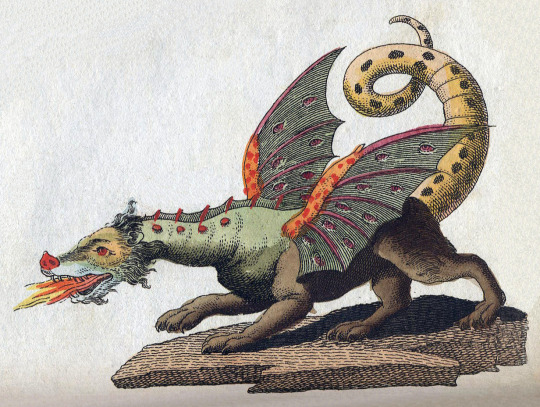
(image: art of a western dragon by Friedrich Justin Bertuch)
Cyndaquil is based on an echidna, an Australian monotreme (egg-laying mammal) that has a long snout and quills like a porcupine.
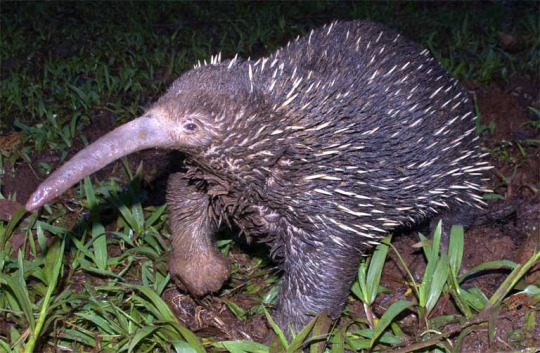
(image: a long-beaked echidna. I don't know why, but its snout makes me very uncomfortable)
Despite being an echidna, its species name is the Fire Mouse Pokémon. This is actually a hint to an additional inspiration for its origin. The Japanese word that got translated to “Fire Mouse” is “Hinezumi”. This is the Japanese name for a monster originating in Chinese legend called the “huǒshǔ”. It’s a flaming mouse that lives in volcanoes. The flaming mammal and volcano association continues through the line. Also, when I googled “hinezumi” the first thing that popped up was the Monster Girl Encyclopedia. If you know, you know (don’t google it). Quilava and Typhlosion completely drop the echidna inspiration, which is a bit disappointing to me. That’s why I made regional variants of them for my Australia/New Zealand fakemon region where they stay as echidnas. While being based on badgers, they retain the quills that are found in many animals, most famously porcupines and hedgehogs. Hisuian Typhlosion is based on Kamuy-huci, the Ainu goddess of the hearth. The Ainu are the indigenous people of Hokkaido, the island that inspired Sinnoh and Hisui. There are multiple Ainu references in Hisui’s design, plot, and regional variants. In the Ainu religion, the hearth was the connection between Earth and the world of spirits and was therefore never allowed to go out. It could also be used to communicate with the kamuy (gods and spirits) and was the passage through which the souls of the dead would leave the world and eventually return for reincarnation. This is why Hisuian Typhlosion is part ghost-type. The fire around H Typhlosion’s neck looks like magatama beads, which are used in the spiritual practices of multiple belief systems. These flames can release 108 ghost lights. 108 is an important number in Buddhism and is the number of beads in a Japamala, another type of beaded necklace used for spiritual practices in (among other religions) certain types of Buddhism.

(image: a japamala with wood beads)
The Torchic line is, I suspect, the place where the trend of basing fire starters on Chinese zodiac animals started. Typhlosion really doesn’t fit the zodiac, though some people say it’s supposed to be the mouse. The line is based on chickens. More specifically, they are based on the basan, a legendary fire-breathing chicken.
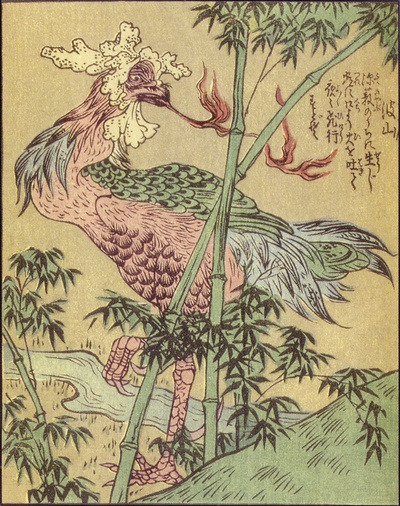
(image: art of a basan by Takehara Shunsen)
Torchic is a chick, a hatchling chicken. It being bright orange comes from a tradition of dying chicks bright colors to be sold at festivals. Male Torchics have a tiny black spot on their rear ends that females don’t. This is probably based on vent sexing, a technique for determining the sex of chocks, a notoriously difficult task. It is done by examining the cloaca, looking for a bump that usually only males have. Combusken and Blaziken are based on cockfighting, a form of animal abuse where people force chickens to fight and bet on the winners. The official art for Blaziken’s normal and mega evolved forms have it in poses used in the martial art of Muay Thai. Blaziken is usually depicted as fighting primarily with kicks and Muay Thai emphasizes kicking. Blaziken being an humanoid with a bird head may also reference the bird-headed Egyptian gods Horus and Ra, or off of the karura, a diving being that looks like a human with a bird’s head in Japanese mythology.
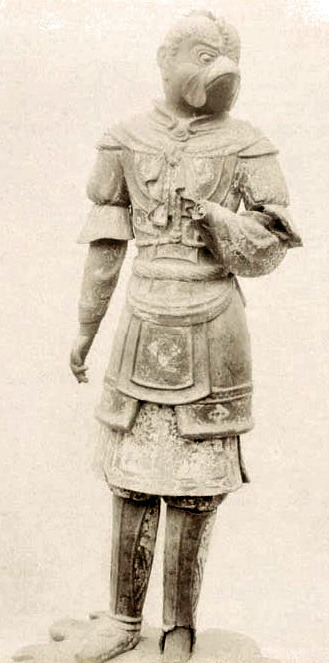
(image: a statue of a karura)
The Chimchar line are based on the monkey from the zodiac. Chimchar’s species name is the Chimp Pokémon, and it does bare some resemblance to a young chimpanzee. When Chimchar’s flame goes out, you can see prominent red marking on its butt. Several monkey species have marking on their hindquarters, but the most famous by far is the baboon. Chimchar’s lack of a tail identifies it as an ape, but its evolved from gain tails, making them monkeys. A lot of people think that apes are separate from monkeys, but really apes are a subset of old-world monkeys. Apes are monkeys, you are an ape, therefore you are a monkey and that’s nothing to be ashamed of. Monferno and Infernape both have prominent facial markings heavily reminiscent of those of mandrills.

(image: a male mandrill's face)
Monferno having blue facial marking and orange fur also makes it look like a golden snub-nosed monkey.
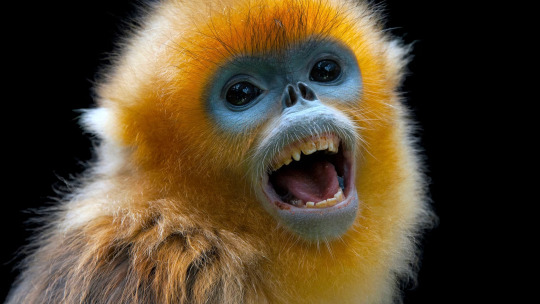
(Image: a golden snub-nosed monkey's face)
These are native to China and the line does have some heavy Chinese influence. The martial art that Monferno and Infernape use is most likely Monkey Kung Fu or Hóu Quán, which was inspired by the movements of monkeys. Infernape is based on the character of Son Goku, the Japanese name for the character Sun Wukong from the Chinese epic novel Journey to the West. Sun Wukong is the king of all monkeys, a martial artist, and has several magic powers.
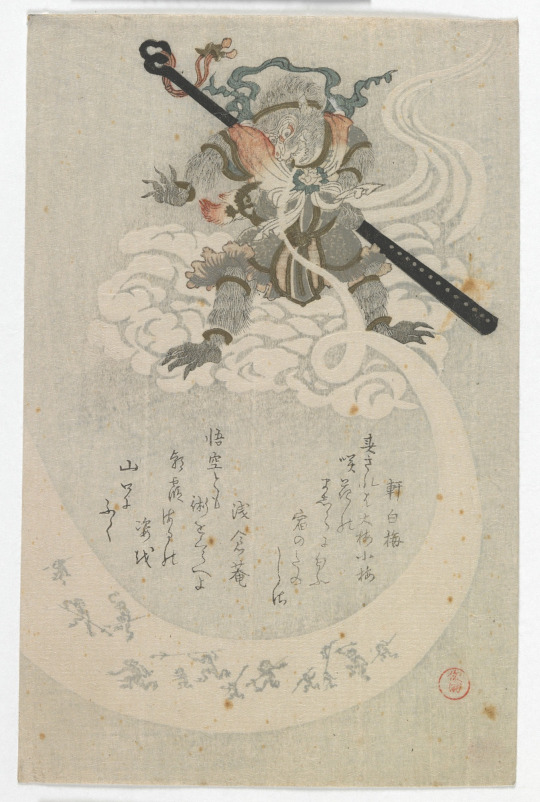
(image: Japanse art of Son Goku/Sun Wukong. Art by Shunman Kubo)
Sun Wukong may be based on the older Hindu god Hanuman, a monkey-like god associated with strength and heroism who was also a member of the varana, a species of monkey people.

(image: a sculpture of Hanuman)
The Tepig line are based on the boar of the zodiac. Ken Sugimori said that the Unova starters were based on different cultures to reflect Unova being a very diverse place. The Tepig line were given Chinese design elements whole the Snivy line were “western” and the Oshawott line were Japanese. Tepig having a dark marking on its head and rear but being light everywhere else comes from the markings of the British Saddleback pig breed.
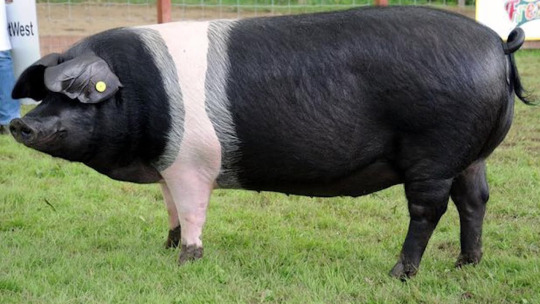
(image: a British saddleback pig)
The fire and pig combination references how pigs are bad at regulating their body head and need to use external sources like mud to cool off. Pignite takes on more boar traits with its exposed tusks. The markings on its body look like it is dressed in a wrestling singlet, which fits as both Pignite and Emboar are based on wrestlers. The yellow markings on Pignite and Emboar resemble patters found in ancient Chinese cauldrons called dings.
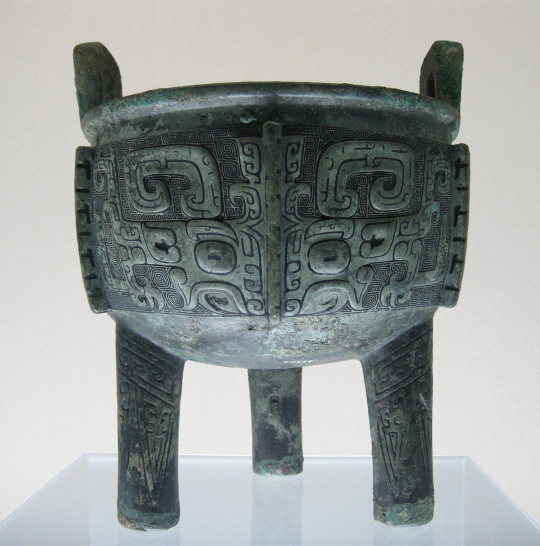
(image: a ding)
Ken Sugimori also stated Emboar was inspired by the character Zhang Fei in the Chinese novel Romance of the Three Kingdoms. In the story, Zhang Fei is betrayed and decapitated by his own men. This could be the purpose of the fire scarf Emboar has, to separate its head from its body. Pignte and Emboar also draw from another Chinese story, the afore-mentioned Journey to the West, specifically the character of Zhu Baije. Zhu Baije is a pig man who joins the titular journey. He is also jealous of Sun Wukong, which kind of fits with how Emboar is a much worse Pokémon than Infernape.
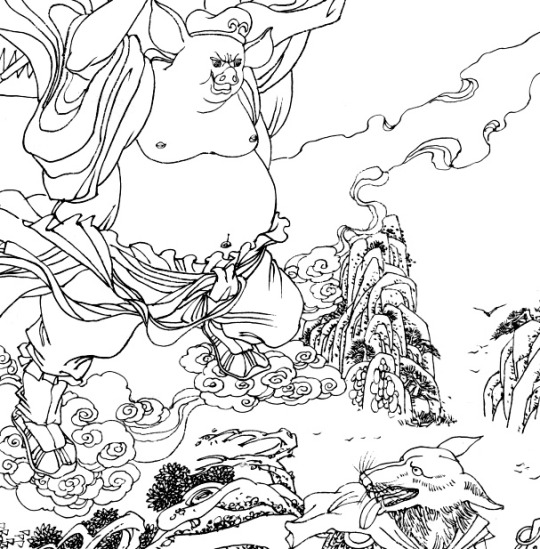
(image: an artists depiction of Zhu Baije. Unknown artist)
The Fennekin like take the place of the fox in the zodiac. Design-wise, their large ears mark them as being based on fennec foxes. They are also based off of the kitsune, magical foxes in Japanese mythology. Among the many powers attributed to kitsune were the ability to breathe fire and perform magic. Kitsune could also take on the form of human women, which is referenced in Fennekin’s evolutions becoming humanoid and having feminine designs.
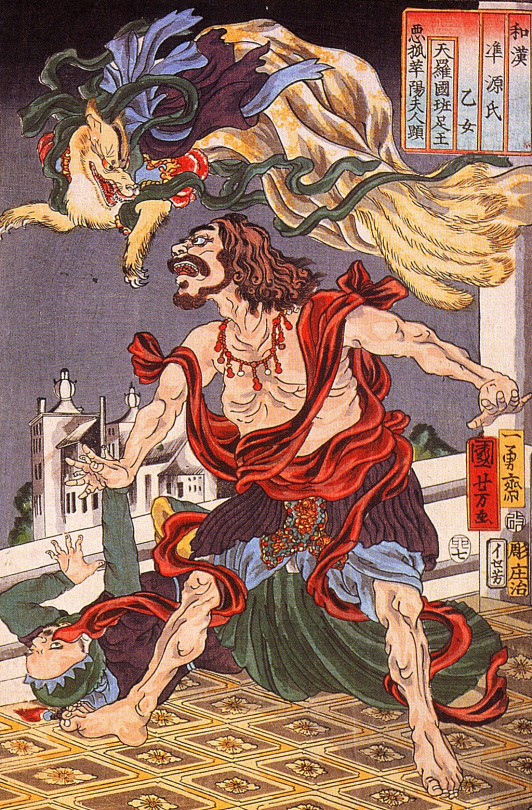
(image: art of a Kitsune scaring two people by Utagawa Kuniyoshi)
Human could also learn magic form foxes, becoming fox witches or kitsune-mochi/kitsune-tsukai. Braixen and Delphox take quite a bit of their design from these fox witches, they also draw from the classic wester witch, using magic wands and Braixen having a tail that looks like the head of a flying broomstick. The association of witches with fire might be a reference to witch burnings. Delphox is also based on a prophet or seer, with its ability to see the future. Delphox’s English name directly references the ancient Greek oracle at Delphi. The final forms of the Kalos starters are based on the fantasy character archetypes of the fighter, the mage, and the thief. Delphox is very much the mage.
Litten is a black cat with tabby cat features. Tabby cats are defined by the stripes on their faces and legs. The orange and black stripes also identify it as the tiger from the zodiac. Its eyes plus forehead stripes are a dead ringer for the alchemical symbol for brimstone, another name for sulfur. Sulfur is a highly flammable element, fitting the fire type. This is one of several references to alchemy found in gen VII.

(image: the alchemical symbol for brimstone. two horizontal lines crossed by a vertical line that leads down into an infinity symbol)
Torracat doesn’t change much from Litten, just adding more stripes and a fireball that looks like a bell on a cat’s collar. It does change when it evolves to Incineroar, and not for the better. Incineroar is my least favorite final stage starter and easily in my top 10 most hated Pokémon. I could go on for a while about how much I hate it, but this isn’t the post for that. It’s still a tiger, but now it has been combined with a professional wrestler. You can tell they really wanted to do another fire/fighting type but knew there would be backlash. The belt of fire is based on a championship belt and its dark type comes from being a heel. In wrestling language, a heel is a villainous character, someone the audience is supposed to boo (a face is a heroic character). This fits with Incineroar being describes as a violent and egotistical Pokémon. However, Incineroar does have a soft side. This fits with how wrestlers are performers playing characters. A performer playing a heel character may cheat, lie, steal, and generally be an asshole while in character, but when not in character they probably won’t be nearly as unpleasant a person.
Scorbunny is the rabbit of the zodiac. More specifically, it is a white rabbit and like with real rabbits, its feet are considered good luck charms. The yellow patch on its face comes from a Japanese character design trope where a bandage over the nose is supposed to indicate that the character is tough and rambunctious. Maylene from the Sinnoh games shares this design element. Its fire typing could come from the Jataka tales, a collection of Buddhist stories from India. In tale 316, a rabbit is placed in a fire as a burnt offering, but it is unharmed by the flame. Another connection could come from the fact that rabbits have unusually high body temperatures for mammals. If Scorbunny is cheerful child, Raboot is a moody teenager. It’s fur and the stripe on its head look like a tracksuit and headband, giving it a connection to athletics. This continues with Cinderace, who is now an association football (or soccer to Americans) player. Football is a huge deal in England, the basis for Galar. Its fur looks like athlete’s attire and it uses a flaming berry like a football. This is another one where you can tell they wanted to make another fire/fighting type.
The Fuecoco line ditched the zodiac theme to become a crocodile. Its upright posture makes it look like a chibified theropod dinosaur and its silhouette looks like a chili pepper. The white face of both Fuecoco and Crocalor resembles a calavera, skull imagery used in the Mexican Day of the Dead. This is a Mexican holiday which is a celebration of dead loved ones that is typically very spirited and cheerful as opposed to glum and mournful. Folklore says the ghost will return to the world of the living on the Day of the Dead. While Paldea is based on Spain and Portugal, several of the new Pokémon have designs based on elements from central and south America, possibly because of both countries’ history of colonialism in those areas. Crocalor adds several references to mariachi players. The flaming nest and egg on its head is a sombrero while the markings on its abdomen look like a traje cordobés, a type of vest often used in mariachi.
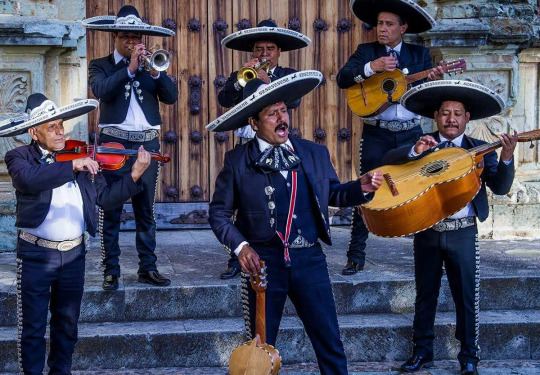
(image: a mariachi band wearing wests and sombreros)
The hat combined with the calavera face makes it look like La Calavera Catrina, a skeleton wearing a wide-brimmed hat that is used as a common symbol in the Day of the Dead.
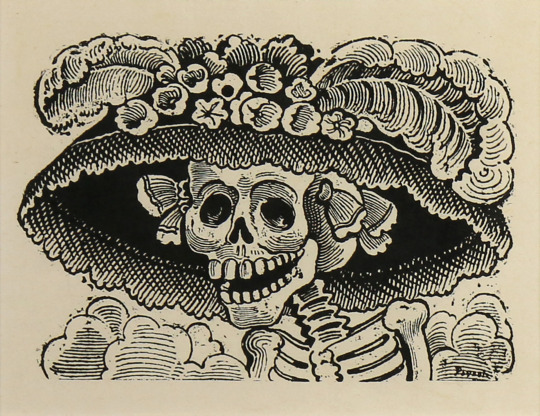
(image: art of La Calavera Catriana by José Guadalupe Posado)
It could also be a bouquet of Tagetes erects, the Mexican marigold, a flow also used for the Day of the Dead. Skeledirge continues the mariachi and Day of the Dead theme by becoming an undead singing crocodile. Real crocodiles will vocalize during mating and nesting season. There are several stories of ghostly or monstrous crocodiles in Spanish folklore, such as the Cocollona and the Drac de Na Coca, the latter of which is displayed as a taxidermied specimen in a museum in the city of Palma de Mallorca. There is also the Coco or Cuca, a boogieman-like that originated in Spain and Portugal and spread to the Americas that is often depicted as a monstrous crocodile. All three of the Paldea starters are based on entertainers and Skeledirge is based on a singer. Given its typing and English name, it probably single funeral dirges. The fiery bird on its nose could come from the gharial, another type of crocodilian. Male gharials have large bumps on the tips of their snouts in the same spot the bird sits.
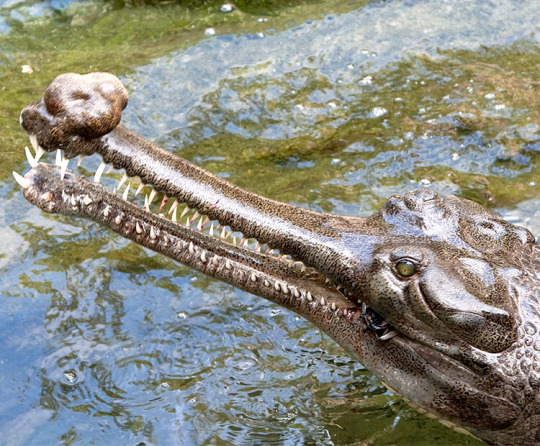
(image: a male gharial)
Another, possibly more likely source is the Egyptian plover, a bird that will land on top of Nile crocodiles and eat parasites off of their skin. Skeledirge could also be based off of alebrijes, very colorful statues of mythical creatures in Mexican folk art. This is making me think about how cool a Mexico-based region could be.
#pokemon#pokemon origins#pokemon lore#fire type#fire starter#charmander#cyndaquil#torchic#chimchar#tepig#fennekin#litten#scorbunny#fuecoco#charizard#typhlosion#hisuian typhlosion#blaziken#infernape#emboar#delphox#incineroar#cinderace#skeledirge
42 notes
·
View notes